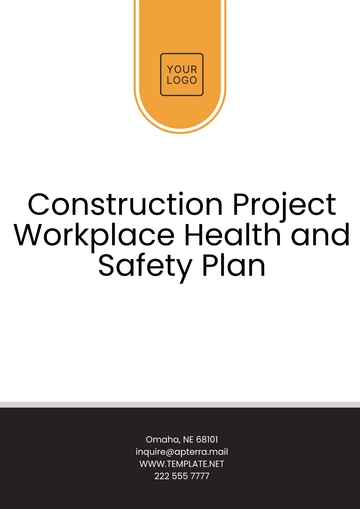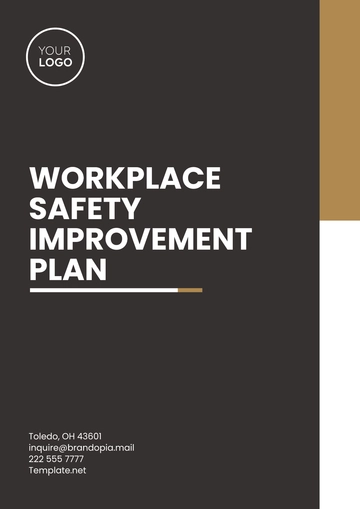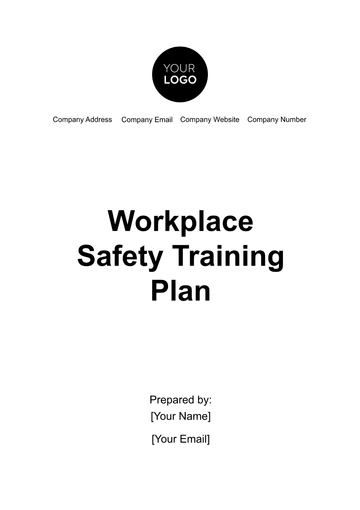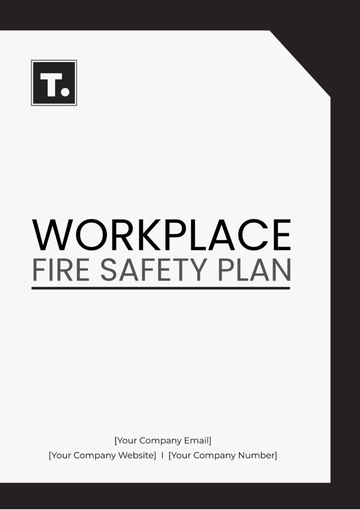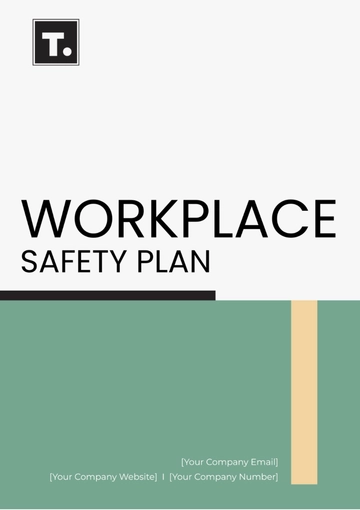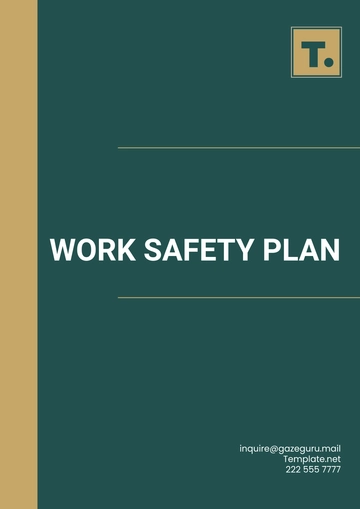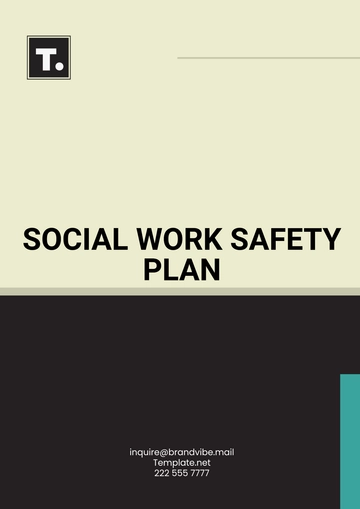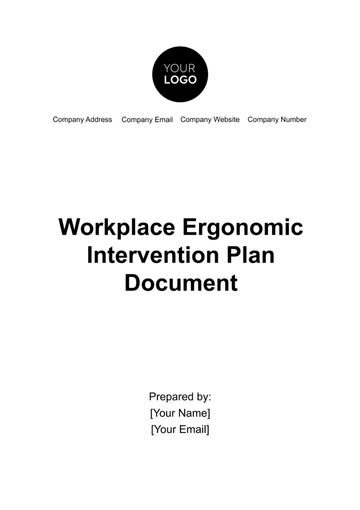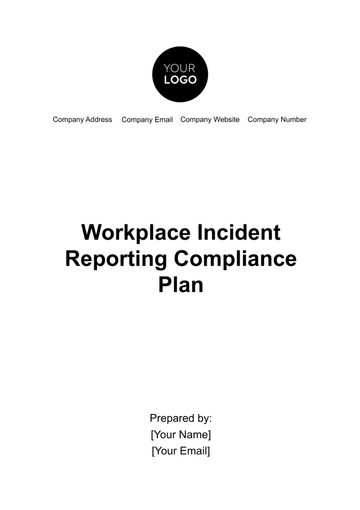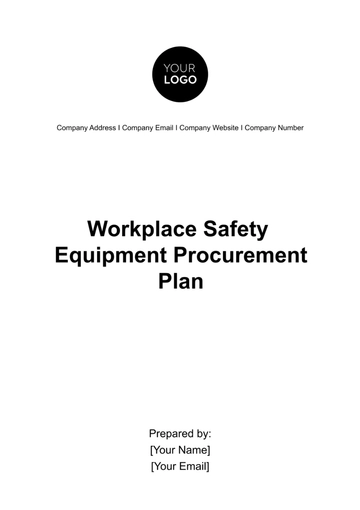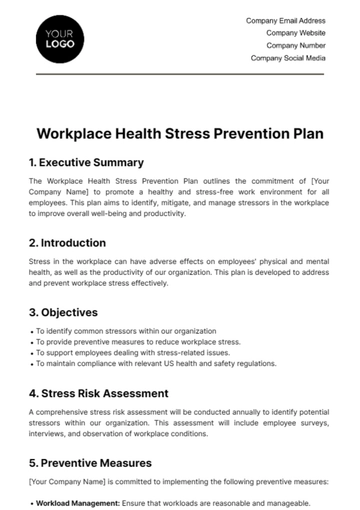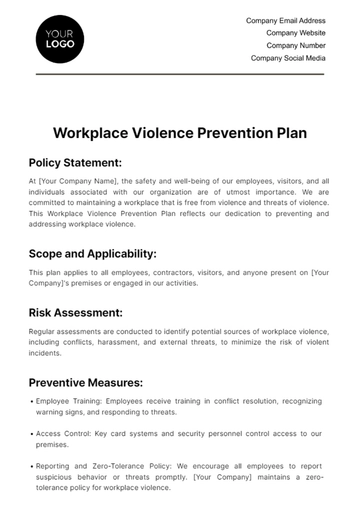Free Workplace Safety Equipment Procurement Plan
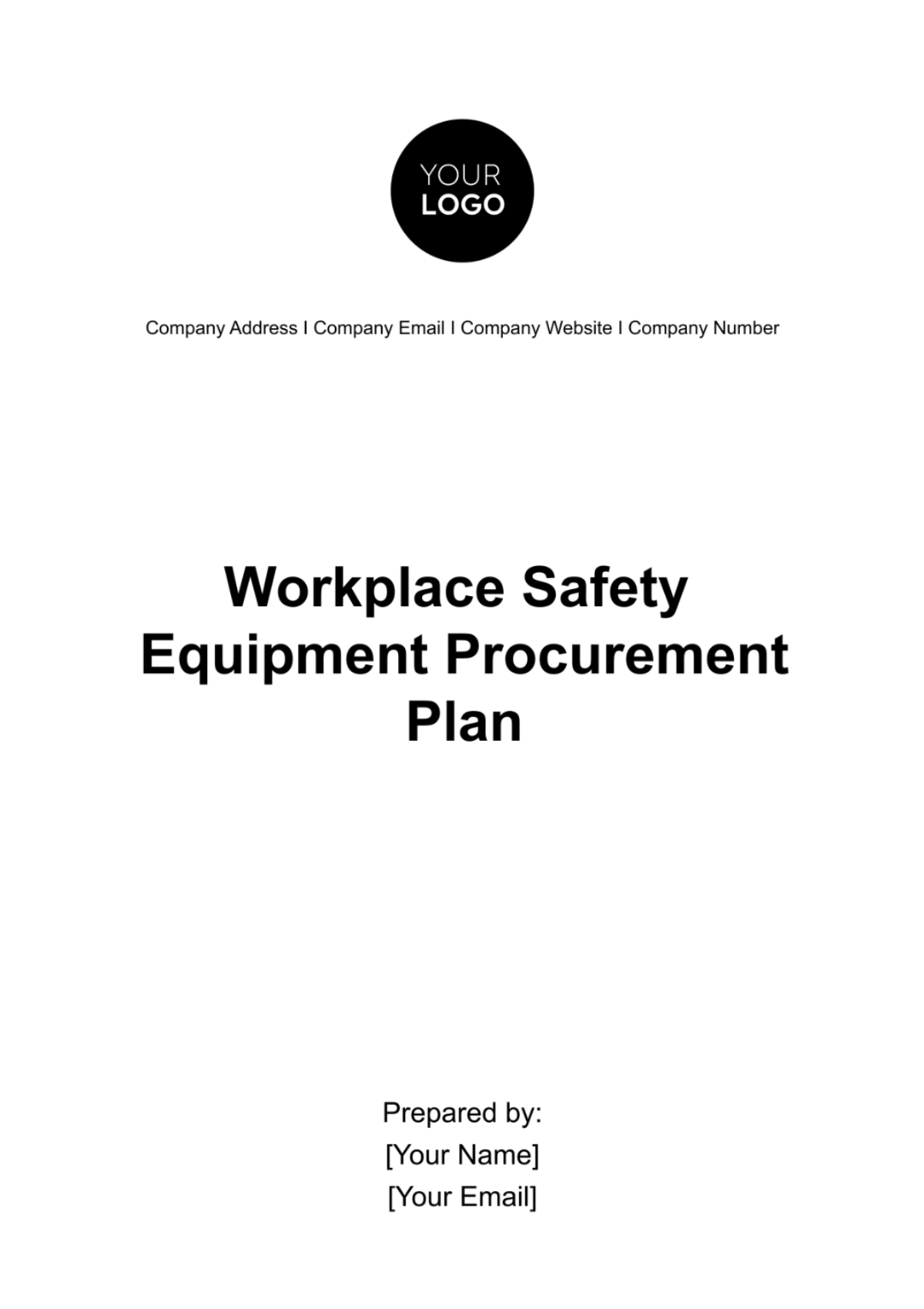
Procurement Plan
I. Introduction
A. Purpose of the Plan
This plan outlines the systematic approach for procuring workplace safety equipment. Its goal is to ensure that all safety equipment purchased meets the necessary standards and requirements, contributing to a safe working environment.
B. Scope of Equipment
The scope includes personal protective equipment (PPE), emergency response items, and ergonomic tools applicable across various departments.
II. Identification of Safety Equipment Needs
A. Hazard Assessment
Perform detailed risk assessments in each department to identify potential hazards.
Involve employees and safety officers in identifying risks based on their daily experiences.
Use historical data of workplace incidents to prioritize equipment needs.
B. Equipment Selection Criteria
Durability: Equipment should withstand regular use without frequent replacements.
Ergonomics: Products must be comfortable and reduce strain for users.
Standards Compliance: Compliance with OSHA, ANSI, and other relevant safety standards.
User Feedback: Consider employee feedback from previous equipment use.
Hazard Type | Equipment Required | Compliance Standard | User Feedback |
Chemical Exposure | Safety goggles, gloves | ANSI Z87.1 | High comfort, easy to clean |
Falling Objects | Hard hats, steel-toe boots | OSHA 1910.135 | Lightweight, durable |
Noise | Earplugs, earmuffs | ANSI S3.19 | Non-intrusive, effective noise reduction |
Repetitive Strain | Ergonomic keyboards, mouse pads | - | Adjustable, supportive design |
III. Budget Planning
A. Cost Estimation
Create a detailed list of all required safety equipment.
Obtain quotes from multiple vendors for cost comparison.
Consider bulk purchasing for commonly used items to avail discounts.
Equipment | Quantity | Estimated Cost per Unit | Total Cost |
Safety Goggles | 100 units | $10 | $1,000 |
Hard Hats | 50 units | $15 | $750 |
Earplugs | 200 pairs | $0.50 | $100 |
Ergonomic Keyboards | 30 units | $40 | $1,200 |
B. Funding Sources
Internal Budget Allocation: Allocate a specific percentage of the annual budget for safety equipment.
Grants and Subsidies: Research and apply for governmental or non-governmental safety grants.
Cost Sharing with Vendors: Explore cost-sharing opportunities with equipment suppliers, such as deferred payment plans or leasing options.
Funding Source | Amount Allocated | Conditions/Notes |
Internal Budget | $10,000 | Allocated annually based on departmental needs |
Safety Grants | $5,000 | Subject to grant approval, used for specialized equipment |
Vendor Cost Sharing | Variable | Terms based on negotiation with suppliers |
IV. Vendor Selection Process
A. Vendor Evaluation Criteria
Reputation and Reliability: Evaluate vendors based on industry reputation, years in business, and feedback from other clients.
Quality Assurance: Ensure vendors provide equipment that consistently meets or exceeds safety standards.
After-Sales Service: Consider the availability of customer service, warranties, and return policies.
Criteria | Questions to Consider |
Reputation | How long has the vendor been in business? What do other clients say? |
Quality Assurance | Does the vendor have certifications? Do they offer product guarantees? |
After-Sales Service | What is the warranty period? Is customer support readily available? |
B. Bidding & Negotiation Procedures
Request for Proposal (RFP): Develop and issue an RFP document outlining specific equipment needs and inviting vendors to bid.
Bid Evaluation: Form a committee to evaluate bids based on predetermined criteria such as cost, quality, and delivery timeframes.
Negotiation: Engage in negotiations with shortlisted vendors to finalize terms, prices, and delivery schedules.
V. Order Management
A. Purchase Order Process
Develop a standardized purchase order form including details like equipment specifications, quantities, prices, and delivery dates.
Establish an approval process involving safety managers and financial officers.
Step | Description |
Form Completion | Fill out purchase order with detailed specifications. |
Approval | Safety manager and financial officer review and approve. |
Submission | Send the approved purchase order to the vendor. |
B. Order Tracking and Verification
Tracking System: Implement a digital tracking system to monitor the status of orders, from placement to delivery.
Delivery Verification: Establish a procedure for inspecting delivered items to ensure they match order specifications and quality standards.
VI. Delivery and Storage
A. Delivery Scheduling
Coordinate with vendors to schedule deliveries in a way that minimizes disruption to daily operations.
Prioritize delivery of critical equipment based on urgency and usage.
Establish a delivery window and communicate this with relevant departments to prepare for receipt and storage.
Equipment Type | Priority Level | Scheduled Delivery Window |
Emergency Response Kits | High | Within 1 week of order |
Protective Wear | Medium | 2 weeks after order |
Ergonomic Equipment | Low | Within 1 month of order |
B. Storage and Maintenance Requirements
Storage Locations: Designate specific, secure storage areas for different types of equipment.
Maintenance Schedule: Develop a maintenance schedule for equipment, especially for items requiring regular checks, such as respirators and fire extinguishers.
Equipment Type
Storage Location
Maintenance Frequency
Fire Extinguishers
Accessible areas on each floor
Monthly check
Safety Goggles
Near workstations
Quarterly cleaning and inspection
Ergonomic Chairs
Office storage room
Bi-annual functionality check
VII. Training and Usage Guidelines
A. Equipment Handling Training
Organize regular training sessions for employees on the correct handling and use of new safety equipment.
Record and track employee participation in training sessions to ensure compliance and proficiency.
Equipment Type | Training Frequency | Key Topics |
Fire Extinguishers | Annually | Operation, maintenance, and safety protocols |
Protective Wear | Bi-annually | Proper fitting, usage, and maintenance |
Ergonomic Equipment | Upon issue | Correct adjustment and ergonomic posture |
B. Usage and Safety Procedures
Develop clear, concise usage guidelines for each type of safety equipment.
Distribute these guidelines through handouts, digital platforms, or posted notices in relevant areas.
Regularly review and update these procedures to incorporate new safety information or changes in regulations.
Equipment Type | Key Usage Procedures | Review Frequency |
Respirators | Fitting, seal checks, cleaning | Annually |
Safety Harnesses | Correct wear, inspection before use | Every 6 months |
Noise-Canceling Headphones | Adjustment, battery maintenance | Bi-annually |
VIII. Monitoring and Evaluation
A. Performance Metrics
Establish key performance indicators (KPIs) to measure the effectiveness of the safety equipment and the procurement process.
Metric | Description | Target |
Equipment Utilization Rate | Percentage of equipment used regularly | >90% |
Maintenance Cost | Annual cost for equipment maintenance | Keep under 5% of purchase cost |
Incident Reduction Rate | Reduction in safety incidents post-equipment implementation | Reduce by 50% annually |
B. Regular Review and Feedback
Conduct quarterly reviews to assess the performance of the equipment against the set KPIs.
Gather feedback from employees on equipment usability, comfort, and suggestions for improvement.
IX. Compliance and Legal Considerations
A. Regulatory Compliance
Ensure all procured equipment is in compliance with relevant local and national safety regulations. Regularly review and update the procurement plan to align with changes in safety laws.
Regulation | Compliance Requirement | Review Frequency |
OSHA Standards | Adherence to Occupational Safety and Health Administration guidelines | Bi-annually |
ANSI Standards | Compliance with American National Standards Institute specifications | Annually |
B. Contractual Obligations
Review and understand all contractual obligations with vendors, including warranty conditions, return policies, and liability clauses.
Maintain a record of all contracts and agreements for easy reference and legal compliance.
X. Plan Revision and Update
A. Continuous Improvement Process
Establish a continuous improvement team responsible for regularly reviewing and updating the procurement plan.
Implement changes based on new industry trends, technological advancements, and feedback from the monitoring and evaluation phase.
B. Revision Schedule and Responsibilities
Schedule an annual revision of the procurement plan.
Assign roles and responsibilities for different aspects of the plan's revision, ensuring involvement from safety managers, procurement specialists, and legal advisors.
Aspect | Responsible Party | Revision Frequency |
Safety Standards Update | Safety Manager | Annually |
Budget Review | Financial Officer | Bi-annually |
Vendor Contracts | Legal Advisor | As needed |
- 100% Customizable, free editor
- Access 1 Million+ Templates, photo’s & graphics
- Download or share as a template
- Click and replace photos, graphics, text, backgrounds
- Resize, crop, AI write & more
- Access advanced editor
Introducing Template.net's Workplace Safety Equipment Procurement Plan Template: your essential resource for streamlining safety equipment acquisition. This editable and customizable template, enhanced by our Ai Editor Tool, simplifies the procurement process. Ensure workplace safety compliance effortlessly with Template.net's innovative solutions for equipment procurement and risk mitigation.
You may also like
- Finance Plan
- Construction Plan
- Sales Plan
- Development Plan
- Career Plan
- Budget Plan
- HR Plan
- Education Plan
- Transition Plan
- Work Plan
- Training Plan
- Communication Plan
- Operation Plan
- Health And Safety Plan
- Strategy Plan
- Professional Development Plan
- Advertising Plan
- Risk Management Plan
- Restaurant Plan
- School Plan
- Nursing Home Patient Care Plan
- Nursing Care Plan
- Plan Event
- Startup Plan
- Social Media Plan
- Staffing Plan
- Annual Plan
- Content Plan
- Payment Plan
- Implementation Plan
- Hotel Plan
- Workout Plan
- Accounting Plan
- Campaign Plan
- Essay Plan
- 30 60 90 Day Plan
- Research Plan
- Recruitment Plan
- 90 Day Plan
- Quarterly Plan
- Emergency Plan
- 5 Year Plan
- Gym Plan
- Personal Plan
- IT and Software Plan
- Treatment Plan
- Real Estate Plan
- Law Firm Plan
- Healthcare Plan
- Improvement Plan
- Media Plan
- 5 Year Business Plan
- Learning Plan
- Marketing Campaign Plan
- Travel Agency Plan
- Cleaning Services Plan
- Interior Design Plan
- Performance Plan
- PR Plan
- Birth Plan
- Life Plan
- SEO Plan
- Disaster Recovery Plan
- Continuity Plan
- Launch Plan
- Legal Plan
- Behavior Plan
- Performance Improvement Plan
- Salon Plan
- Security Plan
- Security Management Plan
- Employee Development Plan
- Quality Plan
- Service Improvement Plan
- Growth Plan
- Incident Response Plan
- Basketball Plan
- Emergency Action Plan
- Product Launch Plan
- Spa Plan
- Employee Training Plan
- Data Analysis Plan
- Employee Action Plan
- Territory Plan
- Audit Plan
- Classroom Plan
- Activity Plan
- Parenting Plan
- Care Plan
- Project Execution Plan
- Exercise Plan
- Internship Plan
- Software Development Plan
- Continuous Improvement Plan
- Leave Plan
- 90 Day Sales Plan
- Advertising Agency Plan
- Employee Transition Plan
- Smart Action Plan
- Workplace Safety Plan
- Behavior Change Plan
- Contingency Plan
- Continuity of Operations Plan
- Health Plan
- Quality Control Plan
- Self Plan
- Sports Development Plan
- Change Management Plan
- Ecommerce Plan
- Personal Financial Plan
- Process Improvement Plan
- 30-60-90 Day Sales Plan
- Crisis Management Plan
- Engagement Plan
- Execution Plan
- Pandemic Plan
- Quality Assurance Plan
- Service Continuity Plan
- Agile Project Plan
- Fundraising Plan
- Job Transition Plan
- Asset Maintenance Plan
- Maintenance Plan
- Software Test Plan
- Staff Training and Development Plan
- 3 Year Plan
- Brand Activation Plan
- Release Plan
- Resource Plan
- Risk Mitigation Plan
- Teacher Plan
- 30 60 90 Day Plan for New Manager
- Food Safety Plan
- Food Truck Plan
- Hiring Plan
- Quality Management Plan
- Wellness Plan
- Behavior Intervention Plan
- Bonus Plan
- Investment Plan
- Maternity Leave Plan
- Pandemic Response Plan
- Succession Planning
- Coaching Plan
- Configuration Management Plan
- Remote Work Plan
- Self Care Plan
- Teaching Plan
- 100-Day Plan
- HACCP Plan
- Student Plan
- Sustainability Plan
- 30 60 90 Day Plan for Interview
- Access Plan
- Site Specific Safety Plan
